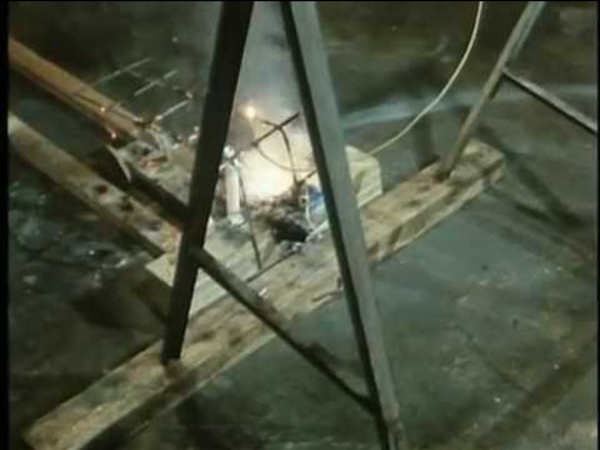



http://www.youtube.com/watch?v=GXrRC3pfLnE
Related: 2016 Juin • Screen based work - researchReclaimed windows and doors form facades of Collage House Old doors and windows, antique wooden columns and metal drainpipes give this house in Mumbai an aesthetic its architects claim is inspired by the ramshackle buildings found throughout the city (+ slideshow). Local studio S+PS Architects designed Collage House to accommodate four generations of the same family. It is located on top of a hill overlooking Mumbai, and is arranged in a traditional Indian style around a central courtyard to avoid unwanted overlooking from neighbouring buildings. The architects were influenced by the ad-hoc building typologies that many of the city's inhabitants construct using found materials. This prompted them to used salvaged materials in their design, helping to promote an alternative approach to recycling.
Pipilotti Rist: Sparkling Pond, Bold-Coloured Groove & Tender Fire, Sydney Last year, Swiss artist Pipilotti Rist brought her hypnotic 30-year retrospective to the MCA. The mesmerising and immersive artworks, dubbed Sip My Ocean, only hung around for four months, but now you can catch another one of her works in Sydney — every night. Sparkling Pond, Bold-Coloured Groove & Tender is Rist's new dazzling artwork, which has just been unveiled beneath Park Lane, one of Central Park's residential towers. Colours and gently animated videos are projected onto three different areas — looking a bit like 'urban electronic bonfires' — every night from sunset till 11pm. As well as colours and images evoking Sydney plants and vegetation, the projections use algorithms of waves to create a 'watery world'. The colourful artworks are free to visit, and touching, sitting and even lying in them is encouraged.
Tim Noble and Sue Webster, Wasted Youth, 2000, trash, replica food, McDonalds packaging, wood, light projector, 210 x 134 x 66 cm Tim Noble and Sue Webster are London-based artists whose work combines assemblage, light, shadow and humor. They aggregate objects and debris into self-deprecating works that bridge two realities. At first glance, we see jumbled piles of trash, the familiar by-products of a throw-away society. The piles evoke the aftermath of a binge, the hangover from a party that went on too long. Unity - Manual: Importing Objects From SketchUp Importing Objects From Blender How to do Stereoscopic Rendering Overview SketchUp is one of the commonly used software for architecture modeling. To use a SketchUp model for visualisation in Unity, user will previously need to convert it to an intermediate format which Unity supports and use the converted format in Unity. To overcome this problem, Unity now supports importing SketchUp file directly into Unity without the need for conversion and allowing user to access certain properties within the SketchUp file within Unity which is not previously possible.
Harun Farocki: Deep Play - Images Conference: "Art is a combat sport": February 9, 7pm, Jean-Marc Huitorel, art critic Symposium: "Images, archives, clues. About the cinema of Harun Farocki and other artistic practices.": March 17, organised with the Master’s programme in Critical and Curatorial Studies Rennes 2 University LiFE – submarine base in Saint-NazaireBoulevard de la Légion d'HonneurAlveole 1444600 Saint-NazaireFrance Hours: Tuesday and Thursday–Sunday 2–7pm T +33 2 40 00 41 68 life@mairie-saintnazaire.fr
Eija-Liisa Ahtila - Interview 2012 Eija-Liisa Ahtila is a masterly and fascinating story-teller in moving images. Her filmic installations challenge the boundaries of our identities and overturn our perceptions of time and space. Her occasionally super-realistic scenarios are based on everyday human experiences and relationships. Fractal Lab - sub.blue History Fractal Lab started around the beginning of 2011 as my first explorations rendering fractals in the browser with WebGL. Previously I had created renderers using Adobe PixelBender and QuartzComposer, which both had the advantage of easy integration into Photoshop and AfterEffects but were very limited when it came to interactively exploring the fractal space. Fractals are by nature highly detailed and so the smallest change to an input parameter can often result in dramatic differences in the output shape. In order to properly explore the space (and discover hidden gems that coalesce at specific parameter combinations) I decided to build a new UI (that had to nice to use!)
Bait review – one of the defining British films of the decade Cornish film-maker Mark Jenkin’s breakthrough feature is a thrillingly adventurous labour of love – a richly textured, rough-hewn gem in which form and content are perfectly combined. A refreshingly authentic tale of tensions between locals and tourists in a once-thriving fishing village, it’s an evocative portrait of familiar culture clashes in an area where traditional trades and lifestyles are under threat. Shot with clockwork cameras on grainy 16mm stock, which Jenkin hand-processed in his studio in Newlyn, Bait is both an impassioned paean to Cornwall’s proud past, and a bracingly tragicomic portrait of its troubled present and possible future. It’s a genuine modern masterpiece, which establishes Jenkin as one of the most arresting and intriguing British film-makers of his generation. Fishing-stock siblings Martin and Steven Ward (“Kernow King” Edward Rowe and Giles King respectively) are at odds.